Do you think your dog has hot spots?
What are hot spots in dogs |
Causes of hot spots in dogs
Diagnosis of hot spots in dogs
Treatment of hot spots in dogs |
Prognosis for dogs with hot spots
Prevention of hot spots in dogs

What are hot spots in dogs

Dog hot spots occur as single, intensely itchy (pruitic) lesions resulting from self-inflicted trauma to the skin. This is because they are extremely irritating and painful.
In an effort to alleviate the constant irritation and pain, dogs will lick or gnaw away at themselves. This leads to further trauma, e.g. inflammation and bacterial infection of their skin.
These irritations are the result of a number of causes where the irritated areas quickly become inflamed and itchy. If left untreated hot spots can develop very fast. In fact hot spots can grow from a coin sized lesions to the size of a human-fist together with inflamed swelling in less than a day.
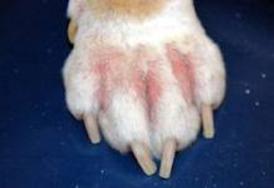
Hot spots usually occur on the chest, ears, hips, limbs and paws, but can develop almost anywhere on the body.
Dog hot spots appear most commonly on the dog's:
- ears
- face just below his ears
- sides of his chest
- flanks
- paws
- rectum
- rump
Dog hot spots symptoms characteristically present as:
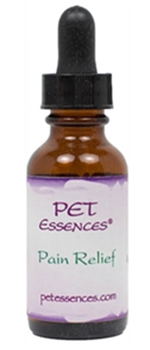
- extremely itchy, circular patches that vary in size.
- red, Painful, swollen, moist and sometimes ulcerated areas of skin
- loss of hair or matted hair very often coated with a serous smelly discharge, which eventually crusts over
- thickening and scarring of the dog’s skin may occur due to its continual self-trauma of licking and chewing
Causes of hot spots in dogs
Hot spots fall into four distinct categories:
- allergic reactions
- parasitic
- pathological
- breed related
Allergic Reactions
Allergy related hot spots in dogs can happen within minutes of a dog being exposed to an allergen it's allergic to, causing symptoms of intense itchiness and pain.
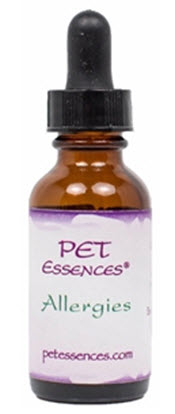
Allergic reactions are the main causes for hots spots in dogs and in particular dogs which have a predisposition to allergy symptoms associated with the following allergens:
- allergic reaction to an injection site
- burs
- constant licking due to boredom or stress
- deep pyoderma
- demodex or Parasitic scabies
- disease of anal gland
- dry skin
- food
- grass awnings
- insect bites and in particular fleas
- insect stings, e.g. wasp stings
- skin wounds
- small cuts and nicks from clipping and grooming
- atopic (something the dog breaths in)
Parasitic
- ringworm (dermatophytosis)
- mange
- yeast infections
Pathogenic
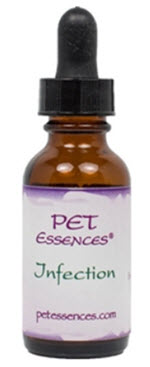
- canine Staphylococcal Pyoderma
- auto-immune disorders
- anal gland problems
- panniculitis
- ear infections
- vasculitis
- arthritis
- hip dysplasia
- reactions to certain drugs or medication
Breed related dog hot spots
Hot spots in dogs are particularly worrisome for breeds with dense long coats, because these two factors make it so easy for burs or grass awnings to embed themselves in the dog’s skin or ears and go completely un-noticed by owners, even with regular grooming.
Skin allergies are known to be the main underlying causes for dog hot spots.
Breeds which have a predisposition for developing hot spots are:
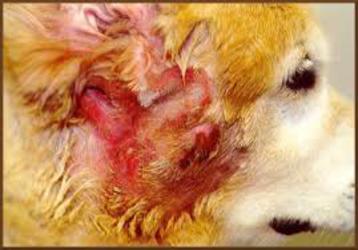
Breed related hot spots in dogs are more prevalent in the heat of summer months - the following chart has been designed to help the reader:
- identify the most common causes and not so common causes of hot spots in dogs
- understand the pathological causes of hot spots in dogs
To view a "Guideline Chart for Causes of Dog Hot Spots" - please click here.
Diagnosis of hot spots in dogs
Hots spots in dogs are easy to diagnose, however, diagnosis of the primary cause is generally made through a process of elimination.
The dog is examined for evidence of “flea dirt” (dried blood excreted by fleas), which indicates flea infestation.
Skin scrapings are examined under a microscope to ascertain if the dog has parasitic, yeast or bacterial infections.
If an allergy is suspected, allergy testing or a convulsions and seizures Elimination Diet Trial will be necessary.
Finally, if all else fails to identify the primary cause, laboratory testing for specific immune or metabolic disorders will be necessary.
Treatment of hot spots in dogs

Regardless of the subsequent choices for systemic and or topical treatment of hot spots, the following procedures are recommended.
A light sedation or topical anaesthetic is normally required to ease the sensitivity and pain associated with treating the lesion
All fur and hair covering and immediately surrounding the lesion should be shaved or clipped.
Gently wash with an antimicrobial shampoo containing either benzalkonium chloride or benzoyl peroxide.
Carole's Doggie World has always been written taking an holistic approach when possible; however, there are times when conventional treatments containing chemicals must be considered. In other words we try to take the best of both worlds for the top treatment options availabe for your precious four-legged friends.
Once your pet is on the mend and you would like to revert to, or consider herbal remedies, please check out our selction of dog shampoos and conditioners in our Allergy Free Products segment.
Take care to ensure that all residual soap is removed and the lesion is patted dry.
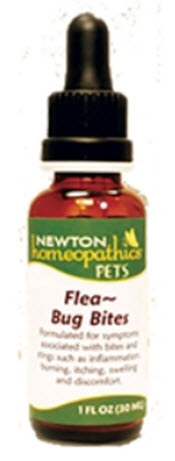
Then gently pat the hot spot with hot spot Flea and Bug Skin Drops
Consider using an Elizabethan collar, to prevent further self inflicted trauma of incessant chewing, gnawing, licking or scratching, all of which will delay healing.
Prognosis for dogs with hot spots
Dogs that recover from hot spots frequently develop recurring lesions related to the primary underlying causes (i.e. allergens, parasites, pathological or breed related). Therefore, identification and elimination of the factors that contribute to hot spots formation are vital for keeping the condition under control.
Prevention of hot spots in dogs
To use an old adage “prevention is always better than a cure”.
Humidity, very often seasonally coincides with the primary conditions, which bring on hot spots. Fleas and other parasites thrive in hot, humid weather.
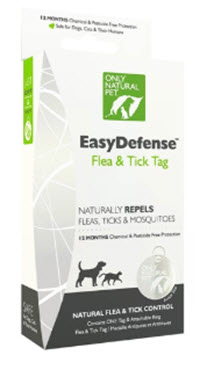
When fleas or other biting or stinging insects are the primary cause of hot spots, systemic or topical flea preventatives or flying-insect repellants such as Flea Tags and Flea Sprays should be applied to your dog.
If ear infections are the problem, frequent swimming can lead to ear infections that may increase risk for dog hot spots. To minimise ear infections and hot spots, try the following:
Cleaning your dog’s ears several times per week and especially after a swim.
Dry your pet’s fur or hair thoroughly because a moist coat in humid weather is one of the leading causes of ear infections, itchy skin and hot spots.
Remove you dog’s collar before swimming or dry it thoroughly if he jumps in before you can remove it. Again, any moisture caused by damp collars can bring on the development of a hot spot.
Certain pollens can exacerbate skin allergies leading to hot spots. Keeping your dog indoors during times of the day when pollen counts peak (usually early morning and early evening) helps reduce exposure to pollen.
This article and information forms part of the Carole's Doggie World Holistic Library and is presented for informational purposes only.The information is not intended to be a substitute for visits to your local vet. Instead, the content offers the reader information researched and written by Carole Curtis for www.carolesdoggieworld.com





